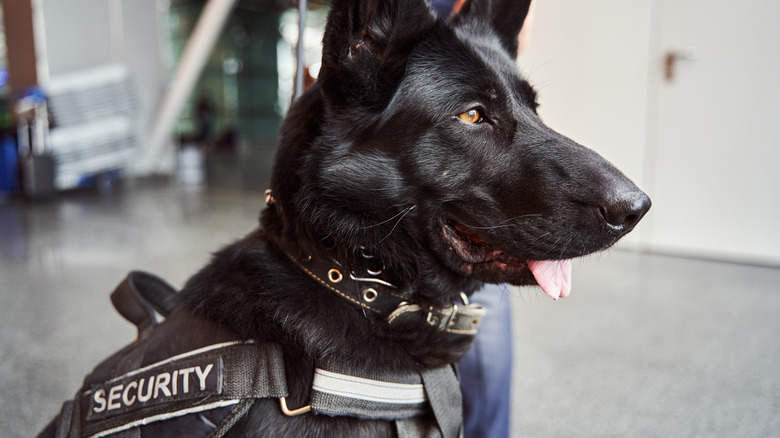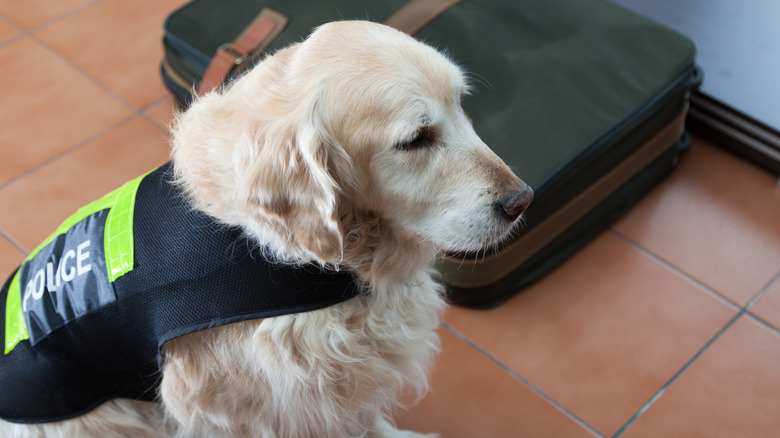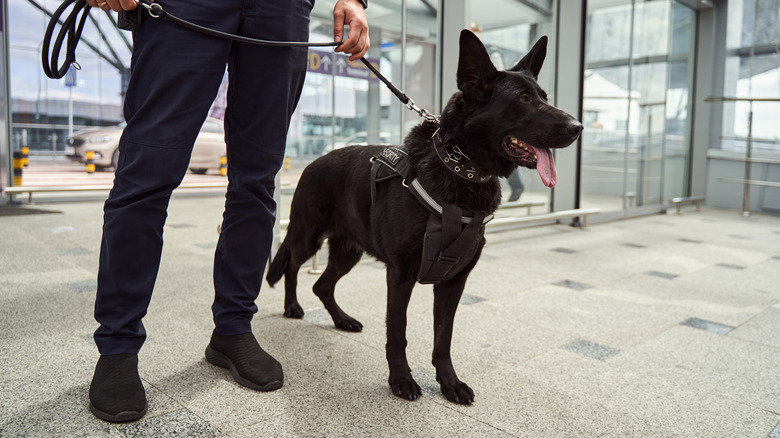Why TSA Might Have You Walk By A Dog Instead Of Taking Your Shoes Off During Screening
A record-breaking number of travelers passed through airport security during the July 4 weekend in 2024, according to CBS News. TSA agents screened over 3 million people on the Sunday after Independence Day, which is the highest number of travelers ever to pass through these checkpoints in one day. Air travel has become more popular than ever, as passengers continue to make up for time lost during the travel restrictions imposed over the last few years and seek new opportunities to create lasting memories. Larger crowds inevitably create delays at security checkpoints, however, particularly when it's necessary to remove your shoes as you pass through screening. It may surprise and delight many travelers to discover that they can keep their shoes on when there is a dog on duty at the gate.
Travelers have been required to remove their shoes during security screening checks ever since the TSA created this rule in 2006, partly due to a person's thwarted attempt to bring dangerous materials onto a flight in a pair of hiking boots. Ever since then, the method of passing one's shoes through a security scanner has become routine as a safety precaution. However, technology has its limitations, and a trained dog is able to detect even the slightest trace of explosive matter. While many travelers know how to follow suggestions, like these tips to get through airport security as quickly as possible, the welcome presence of a canine security agent has made the process simpler and safer for everyone.
Intensive training in realistic conditions
Of course, many travelers apply for TSA PreCheck, the program that allows them to pass through security with their shoes on and their laptops and liquids still in their bags. The good news is that when TSA employs a dog at the gate, it's like every person enjoys the same benefits offered by TSA PreCheck. It's a convenience for passengers and an extra level of security, because even though traditional TSA agents will notice certain characteristics about passengers, a TSA canine is trained to focus on only one thing: detecting explosive materials.
The TSA National Explosives Detection Canine Program has over 1,000 canine teams in place in more than 100 airports and mass-transit systems around the country, per TSA. The program's intensive training is held in San Antonio in partnership with Lackland Air Force Base. The $12 million facility is comprised of 17 indoor and six outdoor locations, all designed to recreate a mass transportation environment, such as a baggage claim area, a security checkpoint, an airport gate, and an aircraft interior. Partnering with Lackland also makes it possible to include actual explosive material as part of the training. The simulated environment includes a lot of commotion, noise, and food odors as diversionary tactics as well. "We don't cut any corners," TSA Canine Training Center branch manager Zebulon Polasek told KSAT. "Everything that you can think of in a mass transit or airport type environment is what we expose these canines to."
Working dogs with a focus
The dogs who qualify for the program must demonstrate a personality and focus that are compatible with the rigorous training, which can last up to 18 weeks. During the training, each dog is paired with a specialized handler who spends this time building a working relationship with the canine, but it doesn't end there. Each dog lives at home with their handler, where they are loved and taken care of like a member of the family. However, the dog is never considered to be a pet. "These are finely trained athletes," TSA spokesperson Patty Mancha told KJZZ. "They're fed a certain diet, they get medical care, they get certain hours of sleep."
When the TSA positions a dog on duty at a security checkpoint, passengers might be directed to walk past a fan that blows their scent toward the dog, who is studying the air for any hint of a dangerous substance in the area. This is the process that often takes place at Sky Harbor Airport in Phoenix, where Andy Tischer is the TSA handler for his dog, Mango. "There's tremendous technology out there and none of it is anywhere near as good as these dogs," Tischer told KJZZ. Taking steps to feel safe while traveling is an important part of any itinerary. When a TSA canine is on the job at your security gate, you can feel confident that safety is the first priority. Keeping your shoes on is an unexpected bonus.


